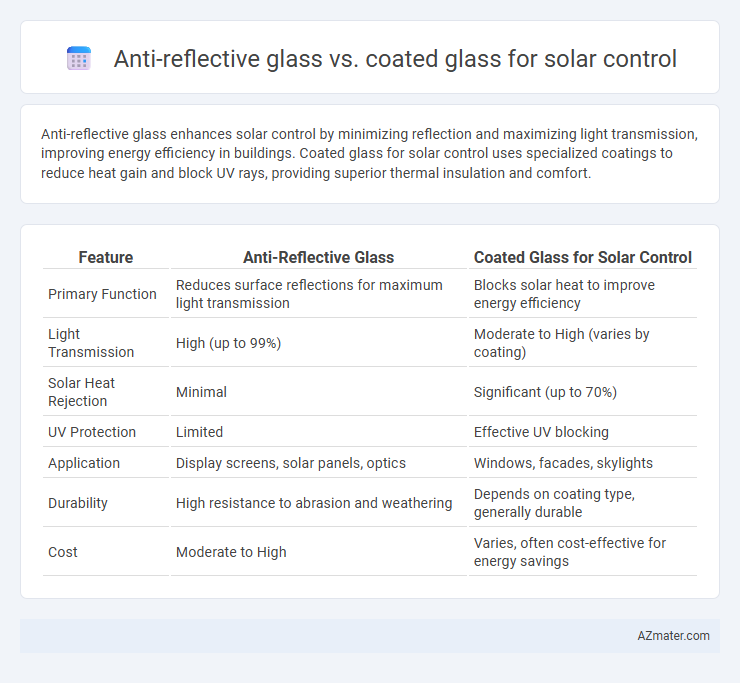Anti-reflective glass enhances solar control by minimizing reflection and maximizing light transmission, improving energy efficiency in buildings. Coated glass for solar control uses specialized coatings to reduce heat gain and block UV rays, providing superior thermal insulation and comfort.
Table of Comparison
| Feature | Anti-Reflective Glass | Coated Glass for Solar Control |
|---|---|---|
| Primary Function | Reduces surface reflections for maximum light transmission | Blocks solar heat to improve energy efficiency |
| Light Transmission | High (up to 99%) | Moderate to High (varies by coating) |
| Solar Heat Rejection | Minimal | Significant (up to 70%) |
| UV Protection | Limited | Effective UV blocking |
| Application | Display screens, solar panels, optics | Windows, facades, skylights |
| Durability | High resistance to abrasion and weathering | Depends on coating type, generally durable |
| Cost | Moderate to High | Varies, often cost-effective for energy savings |
Understanding Anti-Reflective Glass
Anti-reflective glass enhances solar control by significantly reducing surface reflection, allowing more sunlight to pass through for improved energy efficiency in buildings and solar panels. This glass typically features nanostructured coatings that minimize glare and increase light transmission up to 99%, outperforming standard coated glass which relies on thin-film layers to partially block solar heat and UV rays. Understanding the optical properties and durability of anti-reflective glass is crucial for maximizing solar energy capture while maintaining thermal comfort and reducing cooling costs.
What Is Coated Glass for Solar Control?
Coated glass for solar control features a thin, transparent metallic or polymer layer applied to its surface, designed to selectively reflect and absorb solar radiation while allowing visible light to pass through. This coating reduces heat gain inside buildings by minimizing infrared and ultraviolet rays, enhancing energy efficiency and occupant comfort. Compared to anti-reflective glass, coated glass prioritizes solar heat management over glare reduction, making it ideal for temperature control and UV protection in architectural applications.
Key Differences Between Anti-Reflective and Coated Glass
Anti-reflective glass minimizes light reflection to enhance natural light transmission and visual clarity, making it ideal for maximizing sunlight in photovoltaic applications. Coated glass for solar control, such as low-emissivity (low-E) or reflective coatings, primarily reduces heat gain by reflecting infrared radiation, improving energy efficiency in buildings. The key differences lie in their functional focus: anti-reflective glass optimizes light passage while coated glass enhances thermal regulation and solar heat rejection.
Light Transmission Efficiency Comparison
Anti-reflective glass enhances light transmission efficiency by reducing surface reflection to below 1%, allowing up to 98-99% of solar radiation to pass through, which significantly improves solar energy capture. Coated glass, such as low-emissivity (low-E) or solar control coatings, trades some visible light transmission (typically 70-85%) for reduced heat gain, reflecting infrared and ultraviolet rays to improve thermal performance. While anti-reflective glass maximizes light throughput for optimal solar input, coated glass balances light transmission with energy conservation by controlling solar heat, impacting the overall efficiency depending on the application focus.
Solar Heat Gain Regulation
Anti-reflective glass enhances light transmission by minimizing surface reflections, improving solar heat gain efficiency without significantly reducing heat entry, making it ideal for maximizing natural daylight. Coated glass, particularly with low-emissivity (low-E) or solar control coatings, actively regulates solar heat gain by reflecting and absorbing infrared radiation, effectively reducing heat transfer and enhancing indoor temperature control. Selecting coated glass provides superior solar heat gain regulation compared to anti-reflective glass, optimizing energy savings in buildings exposed to intense sunlight.
Glare Reduction Capabilities
Anti-reflective glass significantly enhances glare reduction by minimizing surface reflection, allowing more natural light to penetrate while reducing eye strain and improving visibility in solar control applications. Coated glass, especially low-emissivity or reflective coatings, also decreases glare by reflecting a portion of sunlight but may reduce visible light transmission more than anti-reflective treatments. For optimal solar control performance with effective glare reduction, anti-reflective glass offers superior clarity and light management compared to standard coated glass.
Durability and Maintenance Factors
Anti-reflective glass enhances solar control by minimizing glare and improving light transmission, offering durability through stable chemical coatings resistant to weathering and abrasion. Coated glass, often incorporating specialized solar control films, provides robust protection against UV radiation and thermal stress, though some coatings may degrade faster depending on environmental exposure and cleaning methods. Maintenance of anti-reflective glass typically requires gentle cleaning to preserve the delicate coating, while coated glass demands careful attention to prevent damage to the surface layers that ensure its functional longevity.
Energy Efficiency Impact
Anti-reflective glass significantly enhances solar energy absorption by minimizing reflection losses, leading to improved photovoltaic panel performance and increased energy efficiency. Coated glass for solar control, specifically low-emissivity (Low-E) coatings, effectively reduces heat transfer by reflecting infrared radiation, thereby optimizing indoor temperature regulation and lowering cooling energy consumption. The combination of anti-reflective properties with energy-efficient solar control coatings maximizes solar gain while minimizing thermal losses, resulting in superior overall energy efficiency for building applications.
Cost Analysis: Initial and Long-Term
Anti-reflective glass typically has a higher initial cost compared to coated glass due to advanced manufacturing processes required to minimize surface reflections and enhance light transmission. Coated glass offers a more affordable upfront investment, featuring specialized films or layers that reduce solar heat gain and improve energy efficiency. Over the long term, anti-reflective glass can yield better energy savings and reduced cooling costs, potentially offsetting its initial expense, whereas coated glass may have lower maintenance costs but slightly less effective solar control performance.
Selecting the Right Glass for Solar Control Applications
Selecting the right glass for solar control applications requires understanding the distinct benefits of anti-reflective glass versus coated glass. Anti-reflective glass enhances light transmission by reducing surface reflections, which improves visibility and maximizes natural daylight, ideal for optimizing solar panel efficiency. Coated glass, such as low-emissivity or solar control coatings, selectively blocks infrared and ultraviolet radiation, effectively reducing heat gain and improving thermal insulation, making it better suited for energy-efficient building facades.

Infographic: Anti-reflective glass vs Coated glass for Solar control
 azmater.com
azmater.com